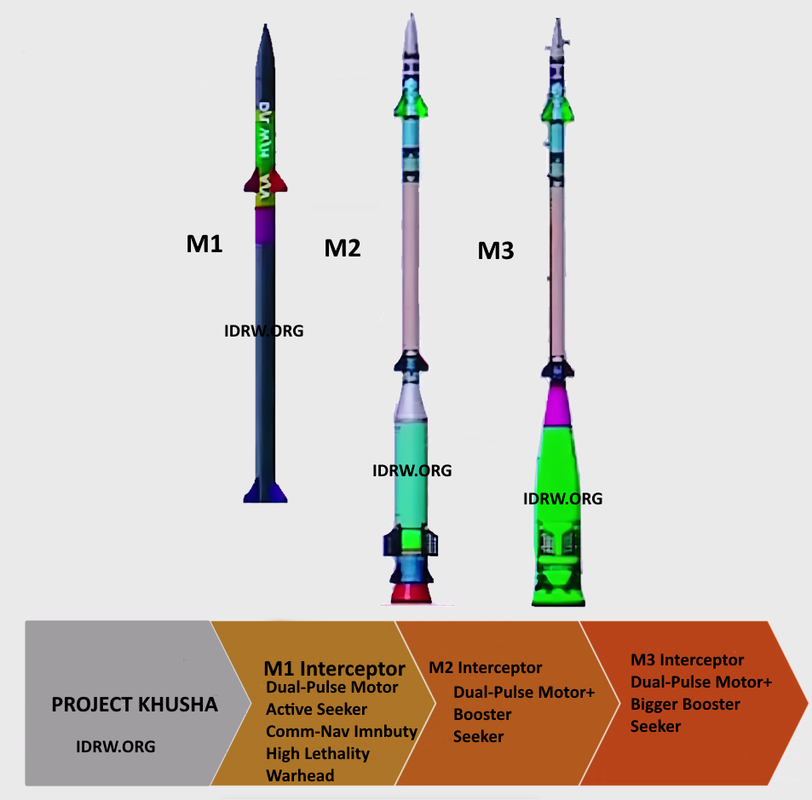SOURCE: AFI


India’s ambitious Project Kusha, a cornerstone of its indigenous air defense strategy, is making significant strides toward bolstering the nation’s multi-layered air defense architecture. The Defence Research and Development Organisation (DRDO), under the leadership of Chairman Dr. Samir V. Kamat, has confirmed that the first development trial of the M1 interceptor missile, a key component of the Extended Range Air Defence System (ERADS) or Programme Long Range Surface-to-Air Missile (PGLRSAM), is scheduled for 2025.
Dr. Kamat announced that the full development of Project Kusha is expected to be completed by 2028, paving the way for its induction into the Indian Air Force (IAF) and Indian Navy by 2028–2029. This development marks a significant step toward India’s goal of achieving self-reliance in advanced air defense systems, positioning Project Kusha as a rival to global systems like Russia’s S-400 and potentially the S-500.
Project Kusha, approved by the Cabinet Committee on Security (CCS) in May 2022 with an Acceptance of Necessity (AoN) in September 2023 for five IAF squadrons at a cost of ?21,700 crore (US$2.6 billion), aims to deliver a transportable, long-range surface-to-air missile system. Designed to bridge the gap between the Medium-Range Surface-to-Air Missile (MR-SAM, 80 km) and the Russian S-400 (400 km), the system will complement existing platforms like the Indo-Israeli Barak-8 and India’s Ballistic Missile Defence (BMD) system. The project, led by the DRDO’s Defence Research and Development Laboratory (DRDL) and Research Centre Imarat (RCI), includes three interceptor variants—M1, M2, and M3—with ranges of 150 km, 250 km, and 350 km, respectively, to neutralize a wide array of aerial threats, including stealth fighters, cruise missiles, drones, precision-guided munitions, and larger targets like Airborne Warning and Control Systems (AWACS).
The M1 interceptor, the first of these variants, is designed to engage targets at a range of 150 km and features an Active Electronically Scanned Array (AESA) seeker, infrared (IR) and radio frequency (RF) guidance, and a dual-pulse solid rocket motor for enhanced maneuverability. The missile’s kill vehicle, equipped with a Seeker Stabilization and Tracking System (SSTS) and thrust vector control (TVC), is optimized for intercepting maneuvering targets, with a single-shot kill probability of at least 90% (and up to 98.5% in salvo mode with two missiles). The system also incorporates advanced long-range surveillance and fire control radars, with interoperability planned with the S-400’s radar network to enhance situational awareness and target engagement efficiency.
Dr. Samir V. Kamat, during a recent statement in Delhi, confirmed that the M1 interceptor missile’s first development trial is slated for 2025, marking a critical milestone in Project Kusha’s timeline. As of August 2024, the DRDO had initiated the fabrication of five M1 missiles, with orders placed for 20 airframe sets, 20 rocket motors, 50 kill vehicles, and telemetry transceivers. The fabrication process, undertaken in collaboration with Bharat Electronics Limited (BEL), is nearing completion, with BEL expected to deliver a prototype within 12 to 18 months, followed by user trials spanning 12 to 36 months. The M1 missile, based on the Akash-NG airframe, has been refined with a booster to achieve its 150 km range, addressing earlier limitations in intercepting maneuvering targets at extended distances.
The M1’s design incorporates advanced technologies, including a 250 mm diameter kill vehicle with a blast fragmentation warhead containing approximately 2,500 fragments. The booster, with a length of over 1,150 mm and a grain mass of around 135 kg, features a high-density ‘Indhan-1’ propellant composition, which the DRDL plans to test in the coming months. The missile’s ability to integrate with the IAF’s Integrated Air Command and Control System (IACCS) and leverage the S-400’s 600 km-range surveillance radars ensures a robust, multi-layered defense grid capable of countering diverse threats.
Dr. Kamat emphasized that Project Kusha’s full development is on track for completion by 2028, with induction into the IAF and Indian Navy expected by 2028–2029. The IAF, as the lead agency, plans to deploy eight squadrons worth approximately ?40,000 crore (US$4.7 billion), significantly enhancing India’s air defense capabilities. The Indian Navy is also developing naval variants of the M2 and M3 interceptors, with the PGLRSAM variant designed to exceed 250 km in range and offer Anti-Ship Ballistic Missile (ASBM) capabilities, strengthening maritime defense against emerging threats.
Project Kusha’s strategic importance lies in its role as a cornerstone of India’s self-reliance in defense technology. By drawing on technologies from the BMD program and integrating proven airframes, the DRDO is reducing development costs and timelines while enhancing system interoperability. The system’s ability to counter stealth fighters, cruise missiles, and ballistic threats positions it as a rival to the S-400, with Phase-II of the project aiming to develop interceptors exceeding 400 km in range and incorporating AI-powered technologies and upgraded radars like the Swordfish, capable of tracking targets up to 1,500 km. This roadmap aligns with India’s need to counter advanced missile capabilities, such as China’s long-range ballistic missiles and its arms transfers to Pakistan, including medium-range systems.
Despite its progress, Project Kusha faces challenges, including reliance on imported components for initial prototypes and the complexity of integrating a multi-layered defense system. Delays in S-400 deliveries due to the Russia-Ukraine conflict have underscored the urgency of indigenous systems like Kusha, with only three of five contracted S-400 squadrons delivered to the IAF as of 2025. The DRDO’s collaboration with private players like BEL and potential partnerships with firms like Tata Advanced Systems will be critical to scaling production and meeting the 2028–2029 deployment timeline.
NOTE: AFI is a proud outsourced content creator partner of IDRW.ORG. All content created by AFI is the sole property of AFI and is protected by copyright. AFI takes copyright infringement seriously and will pursue all legal options available to protect its content.